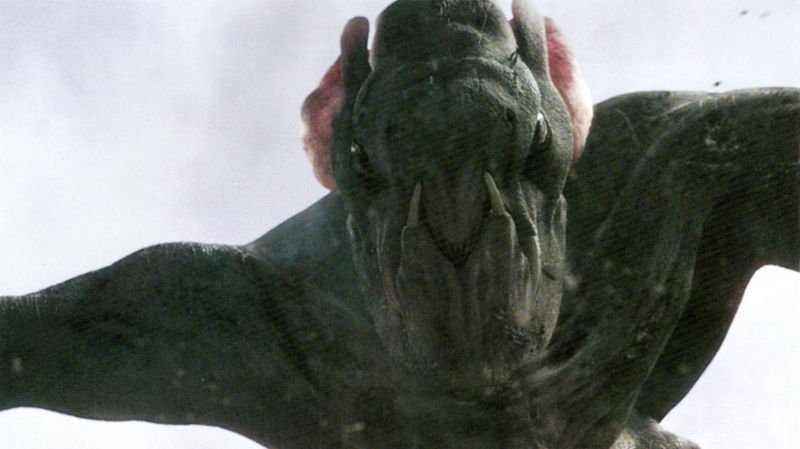 |
| Fig. 1 Theatrical Poster |
It's most innovative feature is the use of "previously recorded" footage to give some backstory to a film that purports to have been recorded over the course of about 6 hours in a linear fashion. This is most effective in the very ending of the film, just after the camera has been bombed by the USAF (mercifully cutting short the emotional video-will of the "hero") and it cuts to the previous day, with the hero and his girlfriend enjoying a happy day out at Coney Island (while in the background a mysterious object can just be glimpsed falling into the sea). The director also manages to sneak in proper cinematic shots under the guise of television news reports, these provide some of the clearest early glimpses of the Monster, as well as the "lice" that drop from its body and promptly seek out any human they can get their many teeth into (an idea that may have seemed clever to the script writers, but lost it's impact as a result of having featured in a video game - dan).
 |
| Fig. 2 Film Still |
The most effective moments in the film occur early on during the attack, as the camera catches brief, unfocussed glimpses of a huge shape moving amongst distant skyscrapers. These snatched sights provide enough information to give a sense of size and alien-ness, but without tying down the audiences mental images with anything concrete (Ebert, 2008). When the monster is finally revealed in full, it seems almost a let down - the worst horror the audience's imagination can conjure is replaced with the special-effects artists idea of a monster. In some ways, the "lice" are more successful at creating fear in the audience - whilst they are shown in their entirity once or twice, it is never for more than a fraction of a second and only as part of rapidly intercut sequences that don't give the viewer time to fully register their appearance.
 |
| Fig. 3 Film Still |
List of Illustrations
Figure 1. Paramount Pictures (Org) (2008) "Cloverfield" Theatrical Poster [Digital Image] At: http://www.impawards.com/2008/cloverfield_ver2.html (Accessed on 02/03/2011)
Figure 2. Paramount Pictures (Org) (2008) Cloverfield [Film Still] At: http://cloverfield.wikia.com/wiki/Clover (Accessed on 02/03/2011)
Bibliography
Corliss, R (2008) Corliss on Cloverfield: The Blair Witch Reject In: Time [Online] At: http://www.time.com/time/arts/article/0,8599,1704366-1,00.html (Accessed on 02/03/2011)
Crust, K (2008) 'Cloverfield' In: Los Angeles Times [Online] At: http://www.latimes.com/entertainment/news/reviews/la-et-cloverfield18jan18,1,7124274.story?coll=la-entnews-reviews-movies (Accessed on 02/03/2011)
Dargis, M (2008) Cloverfield (2008): We're All Gonna Die! Grab Your Video Camera! In: The New York Times [Online] At: http://movies.nytimes.com/2008/01/18/movies/18clov.html (Accessed on 02/03/2011)
Ebert, R (2008) Cloverfield In: rogerebert.com At: http://rogerebert.suntimes.com/apps/pbcs.dll/article?AID=/20080117/REVIEWS/801170302 (Accessed on 02/03/2011)
McCarthy, T (2008) Cloverfield In: Variety [Online] At: http://webcache.googleusercontent.com/search?q=cache:7Z3ABFUSOCUJ:www.variety.com/review/VE1117935799%3Frefcatid%3D31+http://www.variety.com/review/VE1117935799%3Frefcatid%3D31&cd=1&hl=en&ct=clnk&gl=uk&client=firefox-a&source=www.google.co.uk (Accessed on 02/03/2011)
Richards, O (2008) Cloverfield (15) In: Empire [Online] At: http://www.empireonline.com/reviews/reviewcomplete.asp?FID=135091 (Accessed on 02/03/2011)

No comments:
Post a Comment